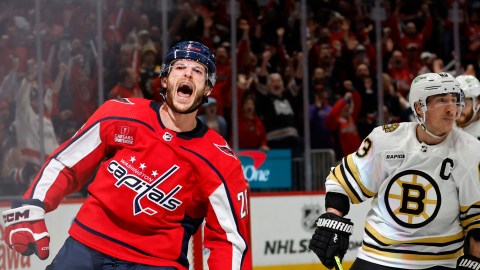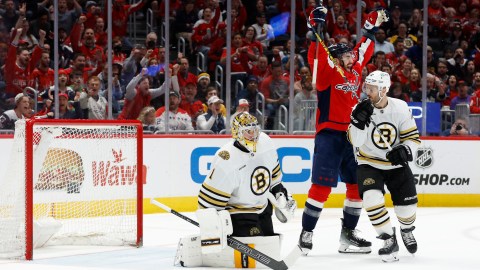Did you know that the Buffalo Sabres had 63 attempted shots to the Bruins' 42 Wednesday night? Did you know that the Sabres outhit the Bruins 17 to 11? That they had nine takeaways to Boston's five?
And people call me a homer.
Some basketball lover decided, quite a while back, that the National Hockey League should have more statistics. So the league appointed off-ice officials to track things like attempts blocked, missed shots, hits, giveaways, takeaways, blocked shots and faceoff wins and losses.
Every NHL team has a staff of part-time workers, the vast majority of whom are really great guys, who wear the NHL blazers and vests and sweaters and stuff the league gives them. We see them in the media dining areas and we see them at press level. Virtually every one of them is a hockey nut, an enthusiast with a lot of passion for the game. But it's doubtful that any of them sees the game the same way as the guy sitting next to him.
In order for statistics to have any hint of validity, the data that comprise them must be easily discernible to any attentive fan. That is, if a stat means anything, anyone who is really paying attention can figure it out himself and come out with the same numbers. The number is objective. The lively discussion and analysis that follows is subjective. That's what makes stats interesting: everyone agrees what "it" is, but there's a lot of argument about what "it" means.
But we have no idea what the "it" is in most of the NHL's statistics.
Pittsburgh assistant general manager Tom Fitzgerald (Billerica boy and Bruin in the 2005-06 season) used to stare in bewilderment at the "Event Summary" sheet. After having thrown his body around with abandon on virtually every shift, he would board the bus shaking his head, saying, "How can I have just one hit in the game?" Most of the time, the answer was as simple as this: NHL stats are in the eyes of the beholders, and most of the beholders are beholden to the home teams.
Nowhere is that more blatant than Buffalo.
For Wednesday night's event summary of a 5-2 game that was nowhere near as close a battle as the score, go to this link.
If the NHL wants its statistics to withstand even mild scrutiny, it needs to have annual formal training of every off-ice official — to do it all at once for everyone in the Eastern Conference and then to duplicate the presentation and execution of the teachings for everyone in the Western Conference.
As much as the Stephen Walkom era of on-ice officiating drove some people nuts with semi-automatic holding and hooking calls, we must give Walkom credit for this: he administered black-and-white standards for those calls. If you took your low hand off the stick and impeded an opponent in any way, you would be serving two minutes for holding. If you made any contact with your stick parallel to the ice, any contact at all, you were going to be gliding to the box on the next stoppage. Fans didn't have to like the standards, but they were standards. Now that Walkom has returned to the ice as a referee, calls are becoming less consistent from game to game. We'll rant about the erosion of the interference standard another time.
The point is that while we knew what hooking and holding were, we have no idea what constitutes a blocked shot or a takeaway.
After a lot of games, Dennis Seidenberg looks like Bonnie and Clyde's car after the Texas Rangers (the real ones, not the American League champs) let loose. The guy is covered with welts and bruises, and usually is sporting a sheepish smile despite all that. Watch your Tivo'd recording of Wednesday night's game and please tell me which of the two-dozen-or-so pucks Seidenberg stopped became his one official blocked shot of the night. It's nonsense.
Standards, training, strict supervision and personnel replacement of incompetent and/or inaccurate data gatherers would be a reasonable step. A better one would be to take these same people who are making subjective judgments and give them objective tasks.
Here are a few:
1. Zone time
Record the clock time of the puck entering and leaving the attacking zones for each team. This is one of those stats that, if the fan at home is really ambitious, he or she can track by fanself (how's that for a gender-neutral word?). Zone time would provide a long view of territorial superiority. In many games, the two teams will be within seconds of one another. In some games, there will be a huge discrepancy. But while the puck is at least 106 feet from a team's goal line it isn't likely to allow too many scores. Over the course of a season, we'll find out which teams really take the puck to the attacking end and put their opponents' feet to the fire.
2. Penalties drawn that put a team on a power play
This is another long-view number, but it reveals hidden value in a player. More often than not, Player A has been caught fouling Player B because B did something that A couldn't deal with legally. Doesn't B deserve credit for putting his team on the power play? Mark Recchi stole the puck from Tyler Myers on Wednesday night. Myers tried to take Recchi's head off and got two minutes for roughing. Credit Recchi.
This — a stat we track at NESN, and I believe we're the only ones who do it — was one of the early indicators that Blake Wheeler was playing effective hockey despite not scoring his first goal until Wednesday night. Wheeler had put the B's on the power play a team-leading four times going into the Buffalo game.
3. Times handling the puck by a goalie
You want to learn how effective a team is at dump-ins to the corners, keeping the puck away from Martin Brodeur? Or whether it actually wants a goalie to play the puck and perhaps turn it over? Or to find out if a team isn't even getting the puck in deep with any regularity? Period to period, game to game, this number would generate a lot more buzz than "attempts blocked."
If you have other ideas, we welcome them in the comments section below. Here are the guidelines: you have to be capable of tracking any one of these stats by yourself while watching the game on TV (assuming the benefit of the omnipresent score/clock graphic) and the statistic must have enough relevance to generate discussion about the story of the game.
I'll take your best five suggestions and email them to the NHL.
When they receive it, they'll hit the "delete" button and go back to surfing the web, pretending that everything they do is right. The guys tracking stats in Buffalo will back them up on that.



